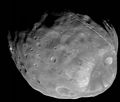Fichier:Phobos colour 2008.jpg

Taille de cet aperçu : 636 × 600 pixels. Autres résolutions : 255 × 240 pixels | 509 × 480 pixels | 815 × 768 pixels | 1 086 × 1 024 pixels | 2 172 × 2 048 pixels | 3 500 × 3 300 pixels.
Fichier d’origine (3 500 × 3 300 pixels, taille du fichier : 2,72 Mio, type MIME : image/jpeg)
Historique du fichier
Cliquer sur une date et heure pour voir le fichier tel qu'il était à ce moment-là.
| Date et heure | Vignette | Dimensions | Utilisateur | Commentaire | |
|---|---|---|---|---|---|
| actuel | 2 avril 2018 à 05:10 |  | 3 500 × 3 300 (2,72 Mio) | Kaldari | more margin on right side |
| 13 novembre 2008 à 06:47 |  | 3 374 × 3 300 (2,7 Mio) | Fir0002 | == Summary == {{Information |Description=Colour image of Phobos, imaged by the Mars Reconnaisance Orbiter in 2008 |Source=NASA |Date=9 April 2008 |Location=http://www.nasa.gov/mission_pages/MRO/multimedia/pia10368.html |Author=NASA/J |
Utilisation du fichier
Les 10 pages suivantes utilisent ce fichier :
- Mars (planète)
- Mars Reconnaissance Orbiter
- Satellites naturels du Système solaire
- Système solaire
- Discussion:Phobos (lune)
- Wikipédia:Le saviez-vous ?/Anecdotes proposées/Archivage des discussions/Archives/2016-2
- Wikipédia:Le saviez-vous ?/Archives/2016
- Wikipédia:Statistiques des anecdotes de la page d'accueil/Visibilité des anecdotes (2016)
- Wikipédia:Statistiques des anecdotes de la page d'accueil/Visibilité des anecdotes (2016)/2016 08
- Modèle:Résumé Système solaire
Usage global du fichier
Les autres wikis suivants utilisent ce fichier :
- Utilisation sur af.wikipedia.org
- Utilisation sur an.wikipedia.org
- Utilisation sur ar.wikipedia.org
- المريخ
- فوبوس
- قمرا المريخ
- ويكيبيديا:صور مختارة/الفضاء والكون/نظرة إلى الأعلى
- قائمة أجرام المجموعة الشمسية مرتبة حسب الحجم
- بوابة:علم الفلك/صورة مختارة
- بوابة:المريخ
- بوابة:المريخ/مقالة مختارة/أرشيف
- بوابة:المريخ/مقالة مختارة/2
- قائمة الأقمار الطبيعية
- خط زمني لاكتشاف كواكب المجموعة الشمسية وأقمارها
- ويكيبيديا:ترشيحات الصور المختارة/القمر فوبوس
- ويكيبيديا:صورة اليوم المختارة/أغسطس 2019
- قالب:صورة اليوم المختارة/2019-08-03
- بوابة:علم الفلك/صورة مختارة/73
- معسكر قاعدة المريخ
- ويكيبيديا:صورة اليوم المختارة/يناير 2022
- قالب:صورة اليوم المختارة/2022-01-04
- Utilisation sur ary.wikipedia.org
- Utilisation sur arz.wikipedia.org
- Utilisation sur as.wikipedia.org
- Utilisation sur azb.wikipedia.org
- Utilisation sur az.wikipedia.org
- Utilisation sur be-tarask.wikipedia.org
- Utilisation sur be.wikipedia.org
- Utilisation sur bg.wikipedia.org
- Utilisation sur bh.wikipedia.org
- Utilisation sur bn.wikipedia.org
- Utilisation sur bn.wikibooks.org
- Utilisation sur bs.wikipedia.org
Voir davantage sur l’utilisation globale de ce fichier.




